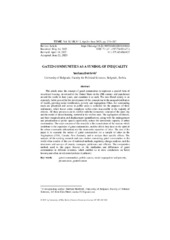Приказ основних података о документу
Gated communities as a symbol of inequality
Oграђена насеља као симбол неједнакости
| dc.creator | Đorđević, Snežana S. | |
| dc.date.accessioned | 2024-03-14T10:05:24Z | |
| dc.date.available | 2024-03-14T10:05:24Z | |
| dc.date.issued | 2023 | |
| dc.identifier.issn | 0353-7919 | |
| dc.identifier.uri | http://rfpn.fpn.bg.ac.rs/handle/123456789/1210 | |
| dc.description.abstract | This article takes the concept of gated communities to represent a special form of securitised housing, developed in the United States in the 20th century and popularised around the world in later years, and examines it as such. The neo-liberal society is an especially fertile ground for the development of this concept due to the unequal distribution of wealth, growing social stratification, poverty and segregation. Often, the surrounding roads are privatised and access to public areas is restricted for the purposes of these settlements, which leaves entire complexes within cities inaccessible to the majority of citizens. All these processes are in conflict with the democratic concept of the open city and the model of mixed housing, nurtured in the welfare state. The segregation of citizens, and their marginalisation and displacement (gentrification), along with the endangerment and privatisation of public spaces significantly reduce the democratic capacity of urban communities. The main concern of this research is the examination of the reasons which contribute to the expansion of gated communities, and the effects they have on the spirit of the urban community (alienation) and the democratic capacities of cities. The aim of the paper is to examine the notion of gated communities on a sample of cities in the Anglosphere (USA, Canada, New Zealand), and to analyse their specific effects. The analysis of the existing research and case studies concerning gated communities in the world often consists of the use of statistical methods, regulatory change analyses, and the interviews and surveys of tenants, managers, politicians and officials. The comparative method, used in this paper, focuses on the similarities and differences of gated communities in different countries, which enabled us to draw conclusions on better housing and urban development policies (synthesis). | sr |
| dc.language.iso | en | sr |
| dc.publisher | Niš : University of Niš | sr |
| dc.rights | openAccess | sr |
| dc.rights.uri | https://creativecommons.org/licenses/by-nc-nd/4.0/ | |
| dc.source | Teme | sr |
| dc.subject | gated communities | sr |
| dc.subject | public spaces | sr |
| dc.subject | social segregation and poverty | sr |
| dc.subject | privatisation | sr |
| dc.subject | gentrification | sr |
| dc.title | Gated communities as a symbol of inequality | sr |
| dc.title | Oграђена насеља као симбол неједнакости | sr |
| dc.type | article | sr |
| dc.rights.license | BY-NC-ND | sr |
| dc.citation.epage | 247 | |
| dc.citation.issue | 2 | |
| dc.citation.rank | M23 | |
| dc.citation.spage | 231 | |
| dc.citation.volume | 47 | |
| dc.identifier.doi | 10.22190/TEME220514016D | |
| dc.identifier.fulltext | http://rfpn.fpn.bg.ac.rs/bitstream/id/3522/fulltext.pdf | |
| dc.type.version | publishedVersion | sr |

